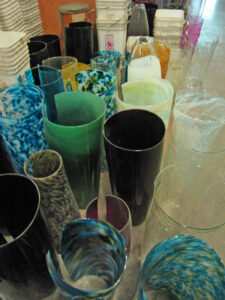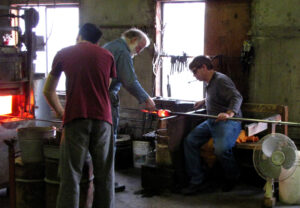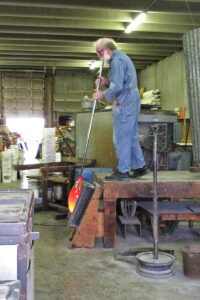by Kirby Lindsay Laney, posted 17 January 2011

Since 1980, the Fremont Antique Glass Company has kept alive an old-world tradition in glass manufacturing. Tucked in a concrete warehouse that sits on the fringes of industrial, residential and commercial areas, the company creates hand-blown sheet glass.
Jim Flanagan runs the ‘factory’ where, with the help of four employees – Asim Kurjakovic, James Musco, Asmorom Tesfi, and Brad Mayoras – he continues a process replaced over a century ago by machine manufacturers and innovations in plate glass. Yet, today, their high-quality ‘Fremont’ glass continues to be sought by stained glass artists and for building restoration projects.
Flawed, On Purpose

A follow-up column will detail the labor-intensive process used to create windows authentic enough for The White House. They’ve also made stained glass for window restoration in a 50-year-old church in Omaha. “If they don’t buy our glass,” Flanagan explained, “they’ll be buying German glass,” as they create the only free blown glass sheets in the U.S. One other company, Blenko, located in Virginia, makes a similar product, but by machine.
“As clean as we blow it,” Flanagan explained, “we can’t make it like plate [glass.]” In fact, they don’t try. Instead, during the blowing process they introduce striations. “People don’t want a uniform product,” he said.

People also want color, and at Antique Glass they play around with color, as time permits. They make flash glass and streakies, two specific methods of introducing color. For the Omaha church, they created a double flash glass – two colors ‘flashed’ on one side of clear glass. Streakies have endless variations, with colors mixed, pebbled, or swirled through the glass. Throughout a day of blowing glass, they work with clear glass and introduce colors as needed, and work in about 3 or 4 color variations a day.
Recycled, For Quality
They can create glass from scratch, but Flanagan has found reusing (melting down) post-industrial window glass more dependable. They can also mix it with soda ash for a lower melting temperature, for flux and so it matches everything else their customers use.

Five days a week, from morning to mid-day, Flanagan and his employees blow 3 to 4 glass cylinders an hour (“depending upon how much decoration,” Flanagan explained.) Afternoons they flatten 15 cylinders an hour. The work requires muscle strength, as well as laboring in a very hot warehouse, year ‘round. All four kilns stay running, as on Saturdays employees can come in to work on their own glass projects.
Originally built as an insulation factory, Antique Glass has filled the cavernous warehouse space with a fascinating assortment of recycled glass shards, color rods, glass cylinders (these can wait to be flattened until customers want the particular color, “this is not like wine,” Flanagan clarified,) and glass sheets ready for shipment.

Flanagan admitted, “Often we don’t know the finished product,” for the glass they make. Fremont Antique Glass is shipped to two basic customers: wholesale stain glass suppliers around the country (plus a distributor in Japan that has sold their glass for 25 years) for sale in small quantities – such as Seattle Stained Glass and Northwest Art Glass – and stained glass artists/studios that can buy, and use, large quantities of stained glass.
Flanagan relies on customers to find the product by word-of-mouth. “There are islands of people who know us,” he stated philosophically, “and great seas of people who haven’t found us yet.” After 30 years, one of those large seas appears to be a majority of the Fremont community – a sea hopefully well set for some overdue displacement.
Related Articles
- An Artist = Hard Work + Reputation
- by Kirby Lindsay, November 9, 2009
- All This, And Sputnik Too?
- by Kirby Lindsay, November 23, 2009
- Handmade In Fremont, By Glass Eye Studio
- by Kirby Lindsay, December 29, 2011
©2021 Kirby Laney. This column is protected by intellectual property laws, including U.S. copyright laws. Reproduction, adaptation or distribution without permission is prohibited.

